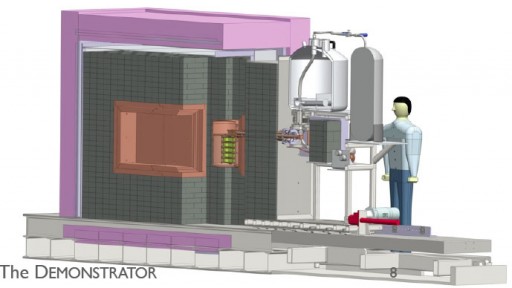Deep underground research could solve matter-antimatter imbalance mystery
May 30, 2013

The Majorana Demonstrator is being assembled and stored 4,850 feet beneath the earth’s surface in enriched copper to limit the amount of background interference from cosmic rays and radioactive isotopes (credit: Oak Ridge National Laboratory)
The Department of Energy’s Oak Ridge National Laboratory has begun delivery of germanium-76 detectors to an underground laboratory in South Dakota in a team research effort that might explain the puzzling imbalance between matter and antimatter generated by the Big Bang.
“It might explain why we’re here at all,” said David Radford, who oversees specific ORNL activities in the Majorana Demonstrator research effort. “It could help explain why the matter that we are made of exists.”
Radford, a researcher in ORNL’s Physics Division and an expert in germanium detectors, has been delivering germanium-76 to Sanford Underground Research Laboratory (SURF) in Lead, S.D., for the project. After navigating a Valentine’s Day blizzard on the first two-day drive from Oak Ridge, Radford made a second delivery in March.
ORNL serves as the lead laboratory for the Majorana Demonstrator research effort, a collaboration of research institutions representing the United States, Russia, Japan and Canada. The project is managed by the University of North Carolina’s Prof. John Wilkerson, who also has a joint faculty appointment with ORNL.
Research at the Sanford Underground Research Laboratory (SURF) in Lead, S.D. is being conducted 4,850 feet beneath the earth’s surface with the intention of building a 40-kilogram germanium detector, capable of detecting the theorized neutrinoless double beta decay of the majorana particle. Detection might help to explain the matter-antimatter imbalance.
Requiring a total of 30 enriched detectors, the Majorana Demonstrator is not expected to be fully complete and operational until 2015.
Those involved in the Majorana research effort believe its completion and anticipated results will help pave the way for a next-generation detector using germanium-76 with unprecedented sensitivity. The future one-ton detector will help to determine the ratio and masses of conserved and annihilated lepton particles that are theorized to cause the initial imbalance of matter and antimatter from the Big Bang.
The Majorana Demonstrator research project is funded by the National Science Foundation and the Department of Energy’s Office of Nuclear Physics.